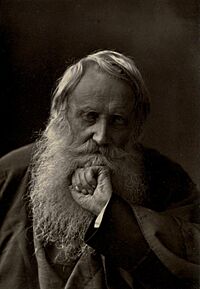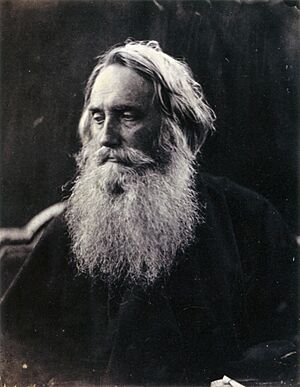Henry Taylor (dramatist) facts for kids
Quick facts for kids
Sir
Henry Taylor
|
|
|---|---|

Sir Henry Taylor, by W. J. Hawker.
|
|
| Born | 18 October 1800 Bishop Middleham, England |
| Died | 27 March 1886 (aged 85) |
| Occupation | Dramatist and poet |
| Language | English |
| Spouse | The Honorable Theodosia Alice Spring Rice |
| Children | Five: including Ida Alice Ashworth Taylor |
Sir Henry Taylor (born October 18, 1800 – died March 27, 1886) was an English writer. He was known for his plays and poems. He also worked as an important official in the British government's Colonial Office. This office managed Britain's colonies around the world.
Contents
Early Life and Challenges
Henry Taylor was born on October 18, 1800, in Bishop Middleham, England. He was the third son of George Taylor Sr. His mother, Eleanor Ashworth, passed away when he was very young.
In 1818, his father remarried, and the family moved to Witton-le-Wear. Henry and his older brother, George Jr., later moved to London for work. Sadly, both brothers caught a serious illness called typhus fever and died within two weeks.
After this sad time, Henry worked for a short period in the colonial government of Barbados. However, his job was soon ended, and he returned home in 1820.
Working for the Government
In 1824, Henry Taylor got a job as a clerk in the Colonial Office. He worked there for many years, until 1872. This office was very important for managing the British Empire.
During his time there, Taylor worked with other officials like James Stephen. They often suggested ways to improve how the government worked. For his long service, Henry Taylor was made a Knight Commander of the Order of St Michael and St George (KCMG) in 1869. This is a special honor given by the British monarch.
Henry Taylor passed away on March 27, 1886.
Friends in the Literary World
Henry Taylor was not only a writer himself but also knew many famous authors. In 1823, he met the poet Robert Southey and they became good friends. Southey was a well-known poet of his time.
Taylor also became friends with William Wordsworth, another very famous poet. He introduced Wordsworth to his cousin, Isabella Fenwick. She became a close friend of Wordsworth and influenced both poets' writings. Taylor even wrote in his autobiography that he wished more of her ideas were in his own work.

Through his work and friends, Taylor met other important thinkers. These included John Stuart Mill, a famous philosopher, and Thomas Carlyle, another well-known writer. Taylor's strong and honest character was noted by Carlyle. He also knew the writer John Sterling.
Taylor was chosen to be the person who would manage Robert Southey's writings after Southey died.
His Writings
Henry Taylor wrote several plays and poems. One of his most famous plays was Philip van Artevelde (1834). This play was so popular that people compared it to the works of William Shakespeare. He also published a book of poems in 1845.
In 1836, he wrote an essay called The Statesman. This essay was seen by some as a funny, critical look at how government workers did their jobs.
In 1885, Taylor published his Autobiography. In this book, he shared his memories and thoughts. He also included descriptions of his famous friends, like Wordsworth, Southey, and Tennyson.
His Place in Literature
During his own time, Henry Taylor was highly respected as a poet and playwright. Many people thought his play Philip van Artevelde was a masterpiece.
Today, literary experts often focus more on his ideas about writing. Taylor believed that poetry should be clear, simple, and well-structured. He thought writers should focus on everyday life and use their intellect in their work.
Family Life
Henry Taylor married Theodosia Alice Spring Rice on October 17, 1839. She was the daughter of Thomas Spring Rice, 1st Baron Monteagle of Brandon. They had five children together. One of their children was Ida Alice Ashworth Taylor, who later became a biographer.


